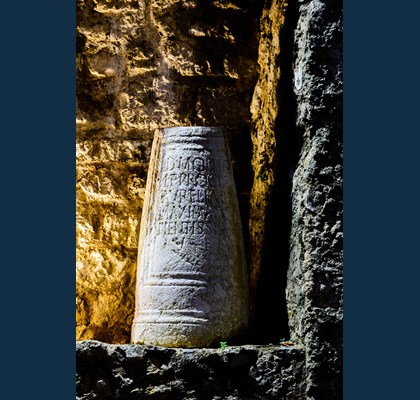Style period: antiquity
Century: 1
A.D.
A cippus is a specific form of a tombstone which appeared in the area of Liburnia, including Krk, during the first three centuries A.D. Over a hundred cippuses have been found until today in the area of north Dalmatia, Kvarner islands and the littoral area. The 14 cippuses found on Krk, although it is presumed there are more, make a special group of cippuses. Five of them are kept at the Castle in Krk, four are situated within the Perossa house (today the catering facility Volsonis), another four are a part of the collection of the Franciscan monastery on the isle Košljun, and one, which has recently been found during the excavations of the church of St Mary of the Spring, is kept in the rooms of the bishop’s residence. The main features of a cippus are its cylindrical body, conical semi-cup above the body which often ends up in a pine-cone shaped acroterium. One cannot but notice their falus-like form. They are more or less adorned by profilations in the base of the body or on the transition between the body and the semi-cup. The inscription fields are often edged with floral wreaths. The semi-cup, or the upper part of the cippus, is often adorned by the motif of scales (squamae), which are described by authors as pine shells or as half-round tiles on the roof of a house. The cippuses on Krk differ from others with their utmost simplicity and a total lack of ornaments. The decorative elements on all cippuses, without exception, are reduced to a simple ring base, with a simple or double profilation of the lower part of the body. They were made of local breccias limestone, which along with the finding of an unfinished cippus, indicates the existence of a local Krk workshop. Almost all cippuses contained the formula D∙M (dis Manibus) in the inscription. This formula, representing an inscription to the gods Mans, the gods of the dead, is common on tombstone inscriptions before the name of the deceased. Besides the inscription formula and the names of the deceased, the inscription often mentions the name of the person raising the monument, the relation with the deceased (son, daughter, wife, husband, faithful servant), and sometimes even the time of death and occupation. As a type of a tombstone, cippuses were monumental and expensive, by far the most expensive monuments of the wider area of Liburnia, so it can be concluded that they represented a certain status symbol of the rich inhabitants, independently of the gender, ethnic affiliation, social level or civil and legal status.
Bibliography:
- Fadić, Ivo, Krčka skupina liburnskih nadgrobnih spomenika, tzv. Liburnskih cipusa – prilog klasifikaciji, Izdanja HAD 13, Zagreb, 1989.
- Kurilić, Anamarija, Komemoratori i pokojnici s liburnskih cipusa: Tko su, što su i odakle su?, Asseria 8, Zadar, 2010.
- Makarun, Matija, Izvještaj s iskopavanja crkve sv. Marije od izvora u Krku, Krk, 2012.
- Suić, Mate, Liburnski nadgrobni spomenik, Vjesnik za arheologiju i historiju dalmatinsku 53, Split, 1952.

